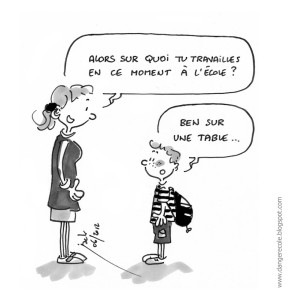Games are a great tool to develop students’ interpersonal skills. While I’ve always used games in my classroom, the types of games have changed as I became more focused on proficiency. The following games, which I’ve “borrowed” from colleagues over the years, are popular with my students and can be used for a variety of communicative goals. In addition, these games can become formative assessments as the teacher circulates around the room providing feedback.
Pair Crossword Puzzles
This is one of my students’ favorite games, and it can be used for students at many different proficiency levels, and in many different contexts. This game takes awhile to prepare, but I think it’s worth the effort!
How to play
1. Students are divided into pairs and each is given a partially completed crossword puzzle. Partner A has the vertical responses filled in, Partner B has the horizontal responses filled in. There are no clues on the puzzle, just the partially completed puzzle
2. The students take turns asking their partner to give them oral clues for the words that are not filled in on their puzzles.
Partner A: Quelle est la réponse pour numéro deux?
Partner B : C’est une légume orange.
Partner A : C’est une carotte ?
Partner B : Non, elle est ronde.
Partner A : C’est une citrouille ?
Partner B : Oui, c’est une citrouille.
How to prepare (using puzzlemaker.com)
1. Make a list of words that will appear in the puzzle. The clue isn’t important, so I just use 1, 2, 3 as the clues, because it’s quick. You need to press enter after each item. I type this in a Word document, rather than in puzzlemaker.com program so that I’ll have it in my files. Here’s an example of a word list (but you’ll probably want to have at least 20 words):
carotte 1
citrouille 2
banane 3
chou 4
2. Go to puzzlemaker.com and choose Criss-Cross.
3. Type a title for your puzzle, and then go to Step 4 (I usually use the default settings for Steps 2 & 3). Copy and paste your word list in Step 4 and click Create my Puzzle.
4. Print 2 copies of the puzzle, as well as a copy of the word list.
5. Fill in the horizontal answers on one copy and the vertical answers on the other. This is the trickiest part, because the computer randomly places your words in the puzzle. So the clue for 1 Across might be “3.” You will have to look back at your word list to see which word was 3 (banane). This will not be confusing to the kids, because they will never see the clues (see below).
6. Depending on the size of your puzzle, the clues (1, 2, 3, etc.) might be on the bottom of the paper (or it might be on the second page). Make sure to white them out/cut them off before copying the puzzles to distribute to the students.
Here are some ideas for contexts that work well for this game:
French 1: Family vocabulary (C’est la soeur de ta mère, c’est le père de ton père, etc.)
French 2: Most concrete thematic vocabulary works well (food/house/clothes/school supplies/classes/sports/etc.)
French 3: I use it for thematic vocabulary, but also for stories. (We read a lot of Petit Nicolas in French 3.) In this case, I don’t necessarily choose new words, but instead focus on key words from the story. This makes it a great way to practice story-telling skills. If you had read Little Red Riding Hood, some clues might be C’est ce que la mère a préparé pour la grand-mère, C’est le personnage qui a tué le loup, C’est ce que la fille aimait porter, etc. The ability to use the language needed for these clues, such as relative pronouns, is a key component in increasing proficiency.
AP French (4/5) I’ve used this game for complex thematic vocabulary, such as in a unit on the environment, as well as to review literature and films.
Jeu de Pyramide
I call the Pyramid game, because it’s based on the game show, $100,000 Pyramid. If you’re old enough to remember this game, you’ll know that the game is based on the first part of the game, not the Big Money (?) part at the end. Like the pair crossword game, this one involves using circumlocution. However, it’s played as a whole class activity, rather than in pairs. I often use this game the day after a pair crossword, because the students will have already practiced describing the words. Fortunately, this one only takes a few minutes to prepare.
How to play
1. The class is divided into two teams. The first 2 players on Team A come to the front of the room. One of them is seated in a chair facing the Smartboard/screen/chalkboard, etc. The other student has his/her back to the Smartboard/screen/chalkboard.
- The student who is facing the screen/board begins by describing the first word on the list to his/her partner who keeps guessing until s/he has guessed all 5 words or time runs out. (I think I give them 90 seconds?, but you could experiment to find the amount of time that works best, depending on your group.)
- Next, the first 2 players on Team B will come up. The game continues until every student has had a chance to play.
How to prepare
1. Because I have a projector, I create a powerpoint with a slide for each word list. In the past, I put them on an overhead. You could also jot them on the board, if that’s all you have.
Devinez Qui
While the board game Guess Who is a great way to increase students’ ability to describe people, I’ve created paper versions that help students practice a variety of other communicative tasks.
How to play
It’s much easier to show you than explain, so here’s an example for a French I unit on school supplies. Devinez qui
How to prepare
1. Find 15-20 clip art pictures that represent images related to the theme you are studying and paste them in a Word document.
2. Type a name and then insert a table (I use 1 row, 10 columns) below the name.
3. Copy and paste 10 of the pictures you have selected in the table.
4. Repeat step 2, but vary the pictures. Ideally, each name will have most of the same pictures because this requires more communication to guess the name. However, you have to make sure that no two names have the exact same pictures. I’m sure there’s a mathematical way to create a template for this, but I just play with it.
One reason I like this game is that it can be used to develop both vocabulary and grammatical structures. For example:
Vocabulary Items: in a backpack, in a refrigerator, in a bedroom, leisure activities, daily routine, etc.
Grammatical Structures:
1. Students can be directed to ask whether the person will do pictured activities (pictures represent various professions, travel destinations, getting married, different colleges, winning the lottery, buying a house, buying a car, etc.)
2. Students can be directed to ask whether the person did the pictured activities. I’ve used this with a unit on vacation, so the pictures showed people flying on an airplane, swimming, sailing, picking up shells, etc.
3. Students can be directed to ask whether the person would do the pictured activities if they won the lottery (pictures represent things that could be purchased, vacation destinations, etc.)
Note: When there is doubt as to what the pictures might represent, I include a copy of all of the pictures and phrase explaining what the pictures represents at the top of the handout.
Qui suis-je/Qu’est-ce que je suis?
How to play
The teacher groups the students in pairs and attaches a paper with a word or picture on one student in each pair. This student must ask his/her partner questions in order to guess what is written/shown on his back.
How to prepare
As it is traditionally described, this game involves taping the papers to the students’ backs. As a result, I never used this game because of the amount of transition time required to make the papers, add tape to the pictures, and attach the papers to the students, none of which could be done in advance because there was no way to store 30 pieces of paper with tape on them. Recently I saw someone describe the same game, but instead of tape, the paper was placed in a blank ID badge holder (see below), that the kids wore so that it hung on their back. I was able to get a class set of these for only a few dollars, and I’ll use yarn to hang them rather than a lanyard, to save money.

In addition to typical novice vocabulary themes, I thought this game might work well for more content-based units that I use with my French 3 classes such as artists (or paintings), endangered animals, historical figures, Fairy Tales, etc.
What games do you use to develop your students’ interpersonal communication?





